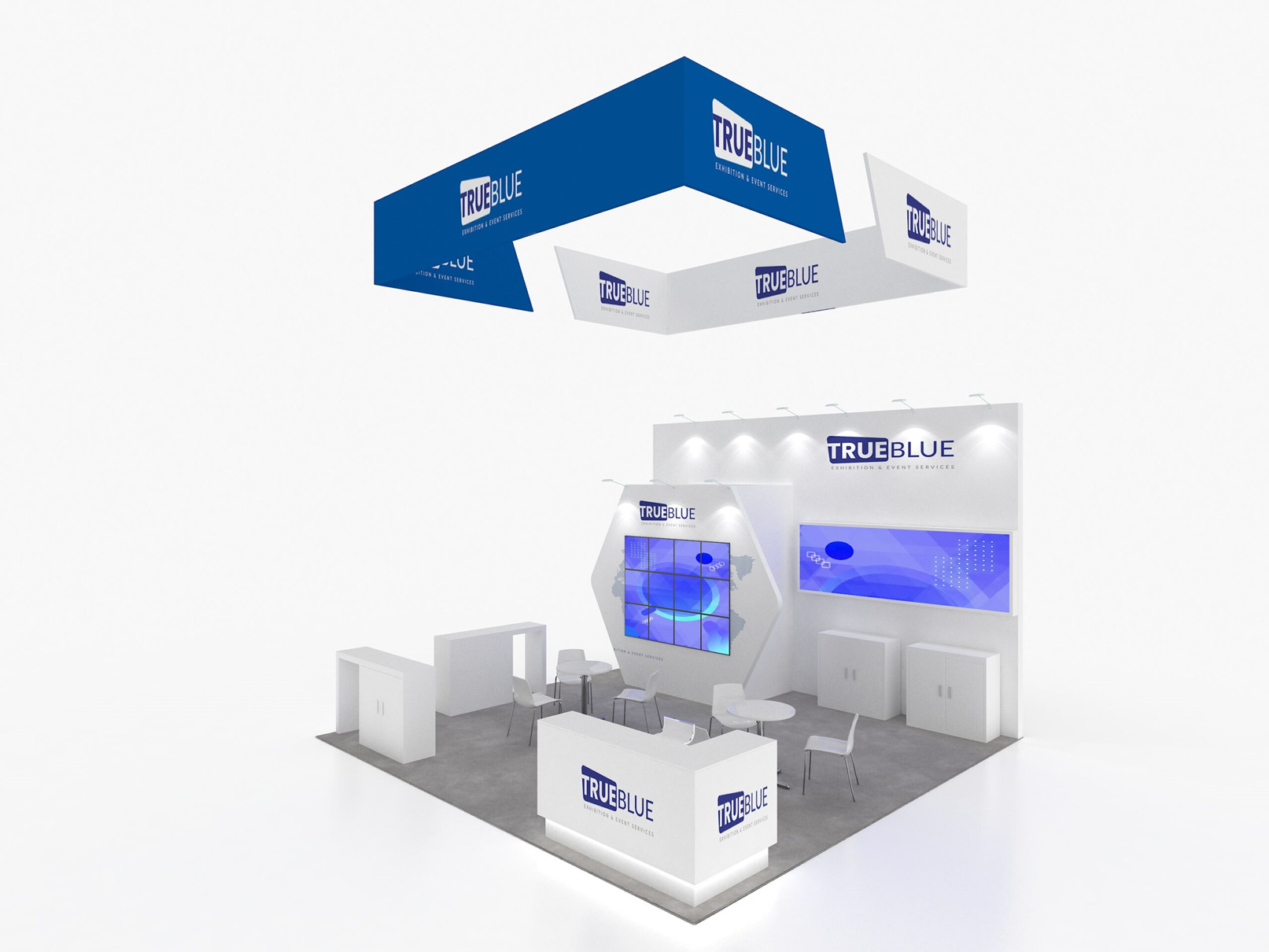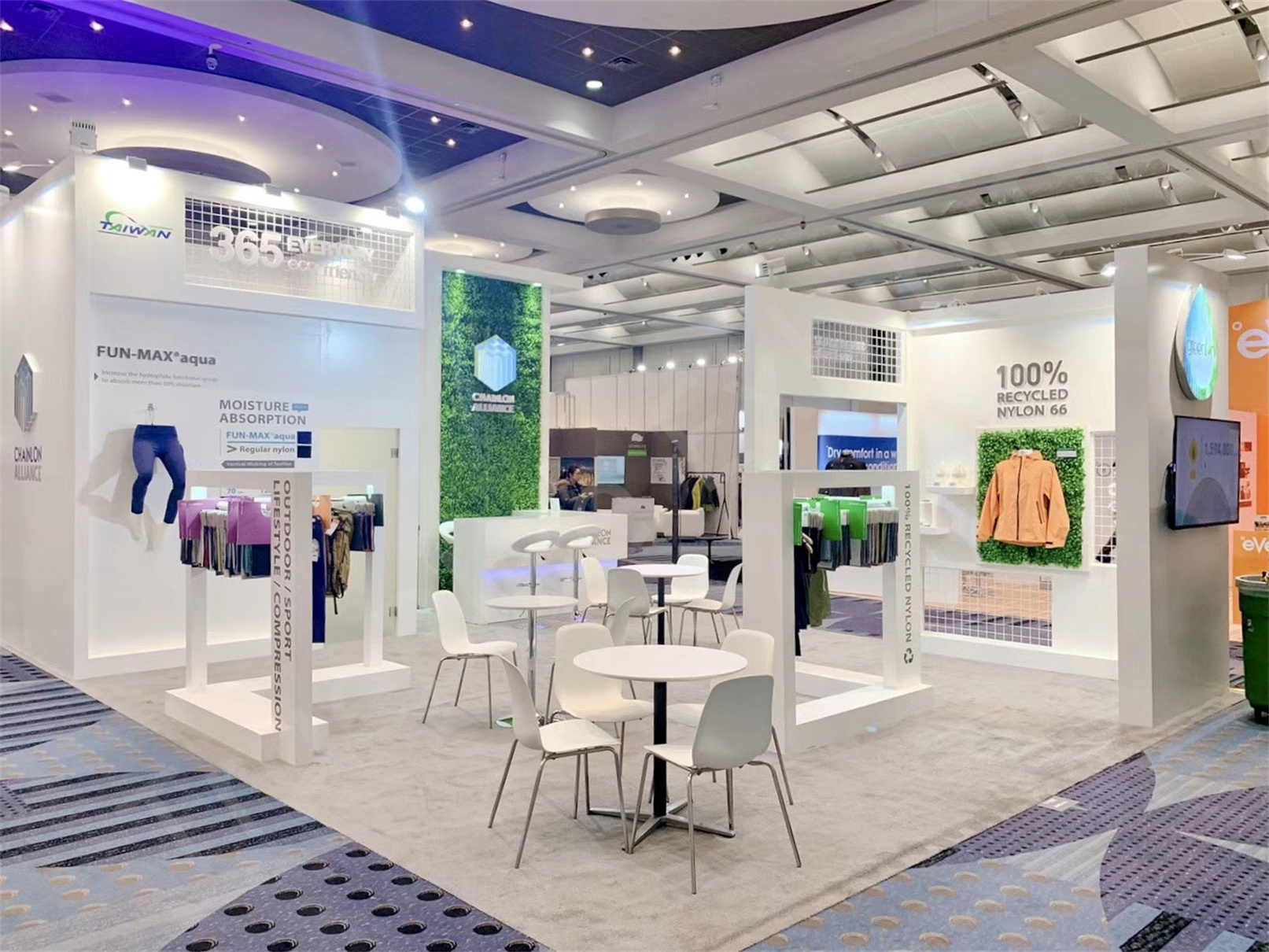1. No freight aisles
2. Cubic space exhibits
3. After-hours access
4. Exhibiting within your own space
5. Suitcasing restrictions
6. Storage behind the exhibit
7. Preferred contractor – exclusive use rules
Table of Contents
The first one, no freight aisles, is easy to understand. The trade show contractors need to be able to move through the exhibit hall, providing exhibitor services, so they will designate certain aisles as “no freight aisles” by adhering tape and signs on the floor that say “NO FREIGHT AISLE.” Forklifts will not set freight in these aisles and neither should you. Simple enough, right?

Source: https://trueblue-exhibits.com/20-x-20-custom-trade-show-booth-portfolio/e4-20-x-20-custom-trade-show-booth-design/
The next item on our list, cubic space exhibits, is more common in public shows and International shows. The term basically means that you can go to full height for your exhibit type throughout your booth location. So if you have a 10 x 10 booth space you are allowed to go 8’ tall anywhere within your space. There is no line of sight restrictions.
With after-hours access, there are two things to watch out for. Let’s start with the basics. The show will publish times for setup, dismantling, and, of course, the show hours. After-hours access would provide access on the show floor outside of these published times. During setup, there are two types of after-hours access. The show may require you to obtain a floor pass to stay on the floor. This pass would have a time limit posted for when you have to leave.
The other type, which is most likely to catch people by surprise, is when the show says that you can stay on the floor to keep working after hours, but if you leave the show floor then you cannot get back in. This is most troubling when clients and exhibitors try to arrive at the show too close to the end of the day, get caught in traffic or something, and unfortunately, they can’t get in – even with an exhibitor badge.
So why do shows have this rule? Well, it’s mostly about security. This is most important on the last day of the show setup. There is a lot of product and equipment on display, and when the day is scheduled to end, two things happen: security staff is reduced, and entrance and exit points are reduced and locked so people can exit but not enter. So fellow exhibitors,
Know what the access rules are before, during, and after the show. Your exhibitor badge does not give you access all the time. I myself have needed to get onto a show floor early during show days. I arrive 2 hours before the show to service maybe three or four clients, only to find out that I am not allowed in until one hour before showtime.
On a side note, make sure to put stuff away in your exhibit each night, especially laptops and smaller pieces of display equipment. Security is not liable for any losses and there are people who have unrestricted access to the show floor, like the cleaning people, building staff, and the general contractor.

Source: https://trueblue-exhibits.com/20-x-30-custom-Las-Vegas-trade-show-booth-portfolio/chainlon-alliance-20-x-30-outdoor-retailer-summer-custom-exhibits/
This seems very simple to understand that you should stay within your own space as an exhibitor, but that’s not all. It also states that, especially when showing demos to customers, the customer should also be within your space so the aisles do not get jammed up with people. However, it is generally accepted that you can have a greeting counter at the front edge of your exhibit for quick introductions and handouts, especially if you have a small linear exhibit.
When doing a longer demonstration, the customer should move past the greeting counter and into your exhibit space. Now, I have seen large group demonstrations, mostly for island exhibits, where there is a big gathering of people standing in the aisle. I have also seen workstations positioned right on the edge of the carpet line. Attendees (and the exhibitor) have no choice but to stand in the aisle for the demonstration. This is where the rule will come into play the most – when you are disrupting traffic flow or your neighbor.
Rule number 5 is often referred to as the “No Suitcasing” rule. It comes from the idea that if you do not have an exhibit on the show floor you are homeless, or “living out of a suitcase.” For shows with a “No Suitcasing” rule, soliciting on the show floor without a booth space can have severe penalties in the future. I see more and more signs posted on the show floor that enforce a “no suitcasing” policy and exhibitors are asked to report this activity.
Penalties for violations include banishment from the show as an attendee and an exhibitor, so be careful. It’s good to check out a show for future consideration. But don’t cross the line by passing out literature or attempting other forms of advertising while at the show. Many shows have a policy that you are required to purchase booth space in order to sign up for sponsorships and place ads in the show program.
Next is number 6: storage behind the exhibit. This rule has two main reasons and varies from show to show. Many exhibitors with smaller exhibits like to put their cases behind the exhibit for easy access after the show. Las Vegas Trade Shows will often prohibit this practice due to fire regulations and just plain ugliness.
You can check and see if the floor plan has a double drape line or a single one, as double drape lines are better for storage when allowed. Other ideas include getting a rental car for storage, or bringing a handcart and taking the empties to your hotel room. Moreover, you can also order a table and store the empties under the table. Many cities only allow small amounts of product and literature storage behind the booth space.
Last but not least is the Preferred Contractor or Exclusive Contractor. Each show and city has different union rules for drayage, labor, cleaning, electrical, and many other show services. The Las Vegas trade show exhibit rules will dictate what you can and can’t do at a particular show. It’s important to remember that when you sign a contract to participate in that show you also agree to the rules of that show. Even though you don’t see the prices and rules until long after you sign the contract.
The Las Vegas trade show exhibit designates specific contractors with exclusive rights to service the show’s needs for the efficiency of the show. I have heard comments like “but this is a right-to-work state” or “the costs are ridiculous.” In addition, I personally have a problem with the exclusive cleaning rule which I covered in an earlier blog.
I always tell exhibitors that if they feel taken advantage of then they should voice their opinion to the show organizer. Without feedback, the show organizer will think everyone is ok with $2,000 internet lines and vacuum unions! Since I’m being a little sarcastic here, I’m sure you know what I mean.
 We Do It Right, The First Time and Every Time
We Do It Right, The First Time and Every Time
 3D Booth Rendering
3D Booth Rendering Always Go
Always Go Win-Win Happy
Win-Win Happy Everything
Everything  Committed
Committed  Customer
Customer Clockwork
Clockwork